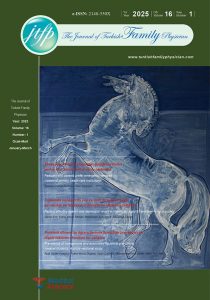Evaluation of chest pain in primary care: Differential diagnosis of emergencies
Chest pain is a common and serious symptom encountered in various medical practices. The complaint of chest pain should always be taken seriously, and the diagnostic process should be expedited swiftly. Since chest pain can be a symptom of various diseases, a rapid differential diagnosis is essential. The most common causes of chest pain are known to be chest wall pain, reflux esophagitis, and costochondritis. However, other potential etiologies, such as pulmonary, psychological, and cardiovascular causes, should also be considered. In approximately 15% of patients with chest pain, a definitive diagnosis may not be established. Therefore, it is crucial to always consider cardiac causes for chest pain and exclude cardiac etiology.
The evaluation of chest pain should include a detailed medical history, physical examination, and appropriate diagnostic tests. Additionally, information regarding the patient’s risk factors and medical history should be collected. Electrocardiogram (EKG) is important in assessing acute coronary syndrome, and it can help decide whether the patient needs to be referred to the emergency department. In the diagnosis of chest pain, predictive tools such as the Marburg Heart Score and the INTERCHEST clinical decision rule can be used alongside clinical evaluation. The rapid and accurate application of the physician’s experience and familiar algorithms is of critical importance in the diagnostic process.
Chest pain may present with different characteristics in different age groups. Therefore, individual characteristics such as age and gender should also be considered during the evaluation. The management of patients presenting with chest pain is of great importance in ensuring the accurate diagnosis and planning appropriate treatment processes. In conclusion, the complaint of chest pain is a serious symptom that requires prompt and effective approaches to provide accurate diagnosis and treatment. Primary healthcare professionals should possess sufficient knowledge and skills in the differential diagnosis and management of chest pain. This plays a critical role in ensuring patient safety and well-being.
References
- Rui P, Okeyode T. National Ambulatory Medical Care Survey: 2016 national summary tables. Accessed from: https://www.cdc.gov/nchs/data/ahcd/namcs_summary/2016_namcs_web_tables.pdf, on 26.11.2023.
- John R Mcconaghy. Outpatient Evaluation Of The Adult With Chest Pain, Accessed from https://www.uptodate.com/contents/ outpatient-evaluation-of-the-adult-with-chest-pain, on 02.05.2023
- Kontos MC, Diercks DB, Kirk JD. Emergency department and office-based evaluation of patients with chest pain. Mayo Clin Proc 2010;85(3):284-99.
- Wright RS, Anderson JL, Adams CD, et al. 2011 ACCF/AHA focused update of the guidelines for the management of patients with unstable angina/non-ST-elevation myocardial infarction (updating the 2007 guideline): a report of the American College of Cardiology Foundation/American Heart Association Task Force on Practice Guidelines. Circulation 2011;123(18):2022-60.
- Işıl A, Bayındır A, Tuncer Ö. Approach to chest pain, Klinik Tıp Aile Hekimliği Dergisi 2017; 1(9): 33-5.
- Wilson SA, Weaver-Agostoni J, Perkins JJ. Acute Coronary Syndrome. In “CURRENT Diagnosis & Treatment: Family Medicine”. (eds) South-Paul JE, Matheny SC, Lewis EL. Fourth Edition. New York, McGraw Hill. 2015:195-204.
- Rude RE, Poole WK, Muller JE, et al. Electrocardiographic and clinical criteria for recognition of acute myocardial infarction based on analysis of 3,697 patients. Am J Cardiol 1983;52(8):936-42.
- Amsterdam EA, Wenger NK, Brindis RG, et al. 2014 AHA/ACC guideline for the management of patients with non-ST-elevation acute coronary syndromes: A Report of The American College Of Cardiology/American Heart Association Task Force on Practice Guidelines. Circulation 2014;130(25):E344-E426.
- Mcconaghy J, Sharma M, Patel H. Acute chest pain in adults: Outpatient evaluation. Am Fam Physician 2020;102(12):721-7.
- Swap CJ, Nagurney JT. Value and limitations of chest pain history in the evaluation of patients with suspected acute coronary syndromes. JAMA 2005;294(20):2623-9.
- Haasenritter J, Bösner S, Vaucher P, et al. Ruling out coronary heart disease in primary care: External validation of a clinical prediction rule. Br J Gen Pract 2012;62(599):E415-E421.
- Aerts M, Minalu G, Bösner S, et al. International Working Group on chest pain in primary care (INTERCHEST). Pooled individual patient data from five countries were used to derive a clinical prediction rule for coronary artery disease in primary care. J Clin Epidemiol 2017;81:120-8.
- Sox HC, Aerts M, Haasenritter J. Applying a clinical decision rule for CAD in primary care to select a diagnostic test and interpret the results [Point-Of-Care Guide]. Am Fam Physician. 2019;99(9):584-586. Accessed from https://Www.Aafp.Org/Afp/2019/0501/P584.Html, on 15.10.2023.
- West J, Goodacre S, Sampson F. The value of clinical features in the diagnosis of acute pulmonary embolism: systematic review and meta-analysis. QJM 2007;100(12):763-9.
- Ohle R, Kareemi HK, Wells G, et al. Clinical examination for acute aortic dissection: a systematic review and meta-analysis. Acad Emerg Med 2018;25(4):397-412.
- Ouellette R. Pulmonary embolism (PE): Practice essentials, background, anatomy. Accessed from https://emedicine.medscape.com/article/300901-overview, on 15.10.2023.
- Wells PS, Anderson DR, Rodger M, et al. Excluding pulmonary embolism at the bedside without diagnostic imaging: management of patients with suspected pulmonary embolism presenting to the emergency department by using a simple clinical model and d-dimer. Ann Intern Med 2001;135(2):98-107.



